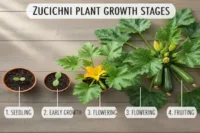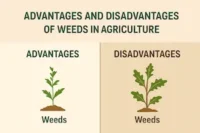Yarrow Companion Plants: Top 10 Flowers, Herbs & Vegetables to Grow Together
Published: 17 Feb 2025
Yarrow is a hardy, low-maintenance plant that benefits gardens and vegetable patches. Known for its beautiful clusters of tiny flowers and strong pest-repelling properties, yarrow attracts pollinators like bees and butterflies while improving soil health. But did you know that pairing yarrow with the right plants can enhance its benefits even further?
In this guide, we will explore the best yarrow companion plants, how they support each other, and why yarrow is an excellent addition to your garden. Whether you’re growing herbs, vegetables, or flower vegetables, yarrow can help create a healthier and more balanced ecosystem.
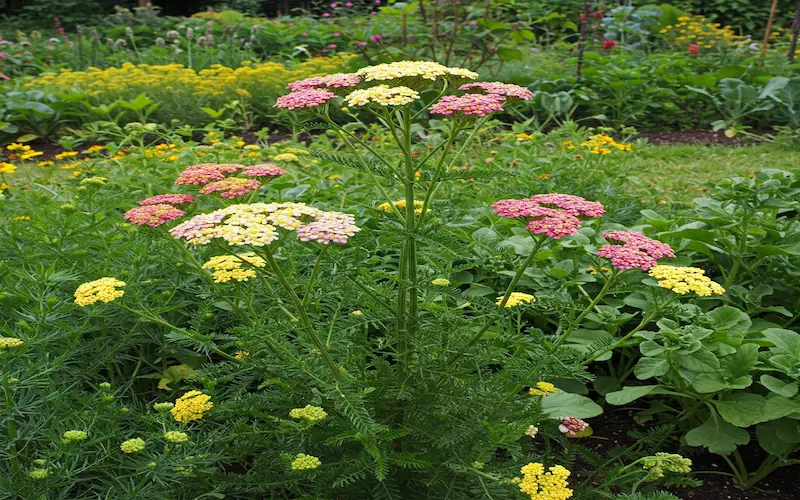
Why is Companion Planting with Yarrow Beneficial?
Companion plants strategically place plants to create a mutually beneficial growing environment. Yarrow is particularly valuable in this practice because of its unique properties:
- It attracts beneficial insects. Yarrow’s tiny flowers are a magnet for bees, butterflies, and predatory insects like ladybugs and lacewings, which help control pests such as aphids and caterpillars.
- It repels harmful pests. The strong scent of yarrow deters mosquitoes, nematodes, and harmful beetles, reducing the need for chemical pesticides.
- Yarrow improves soil quality. It has deep roots that bring up nutrients from the subsoil, making them available to nearby plants. As it decomposes, it enriches the soil with organic matter.
- Yarrow boosts neighboring plant growth. Many plants grow stronger and healthier when planted near the yarrow due to its natural ability to enhance plant resilience and deter common diseases.
- Yarrow thrives in dry, sandy, or rocky soil. It is a great companion for plants that prefer similar conditions, helping conserve moisture in the soil.
With its low-maintenance nature and multiple benefits, yarrow is a valuable vegetable, herb, or ornamental flower in any garden. The right companion plants will maximize these benefits, creating a healthier, more productive garden.
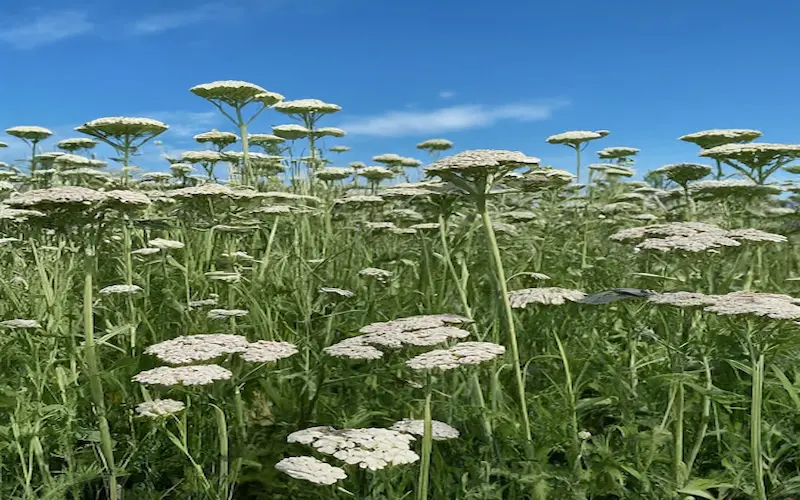
Benefits of Companion Planting with Yarrow
Companion planting is a natural way to improve plant health, deter pests, and boost garden productivity. Yarrow (Achillea millefolium) is one of the best plants for companion planting because of its unique ability to attract pollinators, repel harmful insects, improve soil quality, and support weaker plants. Let’s explore these benefits in detail.
Attracts Pollinators
Yarrow produces tiny, nectar-rich flowers that attract bees, butterflies, and other pollinators. These insects play a crucial role in the garden by helping flowers, fruits, and vegetables set seeds and produce more yield.
- Bees love yarrow because its flowers provide an abundant nectar source. By planting yarrows near fruits and vegetables like tomatoes, cucumbers, and strawberries, you can increase their pollination rates and get better harvests.
- Butterflies are also drawn to yarrow, adding beauty to your garden while helping fertilize plants.
- Beneficial insects like ladybugs, lacewings, and parasitic wasps use yarrow as a habitat. These insects prey on aphids, caterpillars, and mites, which help naturally control pests in the garden.
Repels Pests
Yarrow attracts helpful insects and acts as a natural pest deterrent. The strong scent of its leaves and flowers confuses and repels common garden pests.
- Aphids dislike yarrow’s scent and tend to stay away from gardens where yarrow is planted.
- Mosquitoes are naturally repelled by yarrow, making it an excellent choice for outdoor gardens and patio areas.
- Harmful beetles and nematodes that attack vegetable roots are less likely to infest areas where yarrow is present.
By planting yarrows near lettuce, carrots, and cabbage, you can help protect these crops from insect damage without relying on harmful pesticides.
Enhances Soil Health
Yarrow is deep-rooted, meaning its roots pull nutrients from the lower layers of the soil. It brings them closer to the surface, benefiting shallow-rooted plants. Over time, as yarrow sheds its leaves and flowers, it adds organic matter to the soil, which improves soil fertility.
- Yarrow’s decomposing plant material enriches the soil with nitrogen and other essential nutrients, helping companion plants grow stronger.
- It improves soil structure by loosening compacted soil, allowing better drainage and air circulation around plant roots.
- Yarrow is sometimes used as a green mulch or compost activator to enhance soil health naturally.
Encourages Growth
The plants struggle to grow because of weak root systems, pest issues, or poor soil quality. Yarrow acts as a companion protector, helping weaker plants grow stronger by:
- Attracting pollinators and beneficial insects that support plant health.
- Repelling pests that commonly weaken vegetables and flowers.
- Sharing nutrients by drawing minerals from deep within the soil and making them accessible to shallow-rooted plants.
For instance, tomatoes and cucumbers tend to be prone to pest infestations. Growing yarrow nearby reduces the risk of pests and boosts their overall resilience.
Low Maintenance
One of the best things about yarrow is that it doesn’t require much care. It grows well in dry, sandy, or rocky soil, ideal for low-maintenance gardens.
- Drought-Tolerant: Yarrow can survive with minimal water, making it an excellent choice for areas with hot, dry summers.
- Thrives in Poor Soil: Unlike many plants needing nutrient-rich soil, yarrow adapts well to poor soil conditions and benefits neighboring plants.
- Hardy and Perennial: Once established, yarrow returns yearly, providing continuous benefits to your garden.
Even if you forget to water your yarrow plants, they’ll continue flourishing and supporting your other crops without much effort!
Final Thoughts
Adding a yarrow in the garden is a natural support system for your vegetables, herbs, and flowers. From attracting helpful insects to repelling pests and improving soil health, yarrow is one of the best companion plants you can grow.
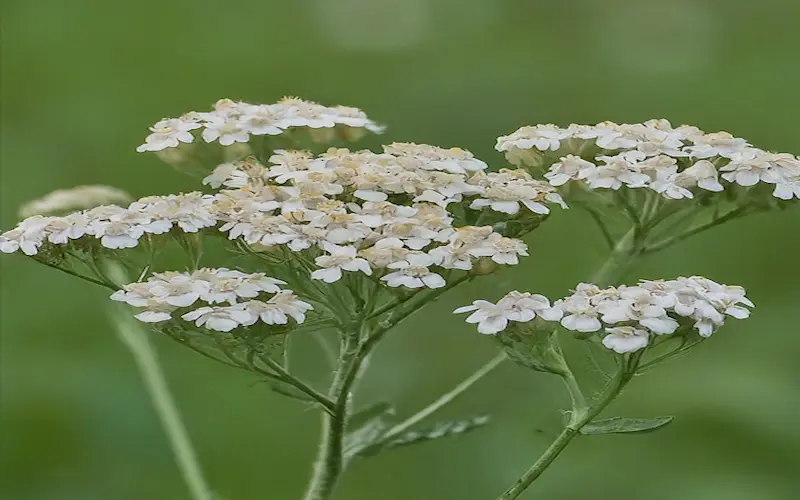
What to Plant with Yarrow
Yarrow is a versatile and beneficial plant that works well in companion planting. It attracts pollinators like bees and butterflies while also repelling harmful pests. Some great companion plants for yarrow include lavender, echinacea, rosemary, and basil, as they thrive in similar growing conditions. Yarrow also enhances the growth of vegetables like tomatoes and peppers by improving soil health and deterring pests. Additionally, it pairs well with flower vegetables such as broccoli and cauliflower, promoting biodiversity in the garden.
Best Yarrow Companion Plants
Companion planting with yarrow (Achillea millefolium) is a great way to improve plant health, attract beneficial insects, and enhance your garden’s resilience. Yarrow pairs well with various vegetables, herbs, flowers, and fruit plants, making it a versatile and valuable addition to any garden.
Let’s explore the best plants to grow alongside yarrow and how they benefit from this hardy, low-maintenance companion.
Yarrow is an excellent companion for many vegetables, herbs, flowers, and fruit plants as it repels pests, attracts pollinators and improves soil health.
Tomatoes
Tomatoes are vulnerable to aphids, whiteflies, and hornworms. It can damage leaves and reduce fruit production. Yarrow naturally repels these pests while attracting ladybugs and parasitic wasps that help keep harmful insects in check.
Yarrow enhances the flavor of tomatoes by improving soil conditions and nutrient absorption. Plant the yarrow near tomato beds to support healthier growth and tastier fruit.
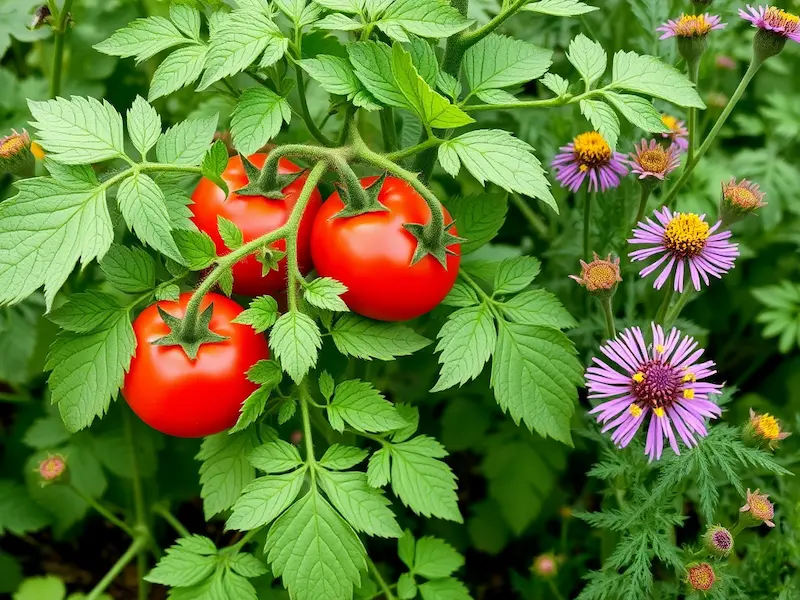
Lettuce
Lettuce is a delicate leafy vegetable that often attracts aphids and slugs. The strong scent of yarrow is a natural deterrent, helping to keep these pests away.
Lettuce has shallow roots, so planting it near deep-rooted yarrow prevents nutrient competition. This allows both plants to thrive without affecting each other’s growth.
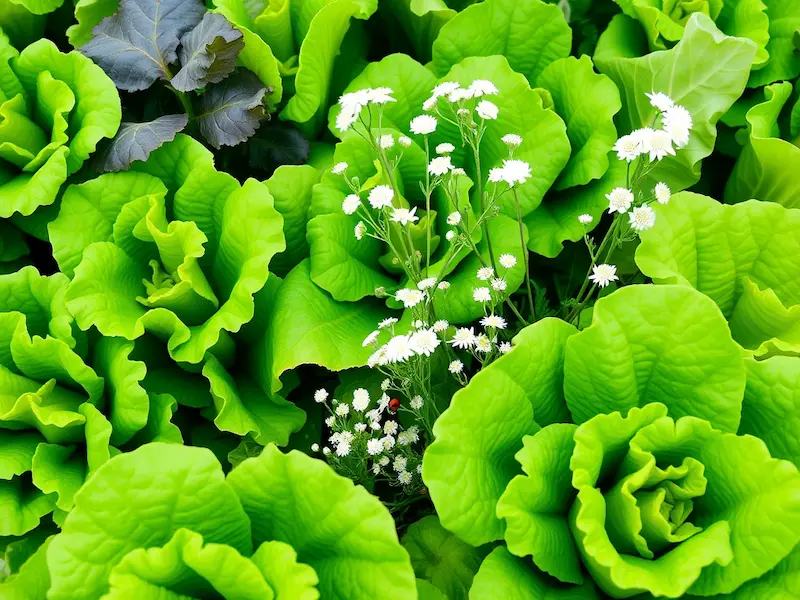
Cucumbers
Cucumber plants rely on pollinators like bees and butterflies to produce fruit. Yarrow’s colorful, nectar-rich flowers draw these essential insects to the garden, ensuring better pollination and higher cucumber yields.
Planting yarrows around cucumber vines can also help protect against cucumber beetles and other pests that damage leaves and stems.
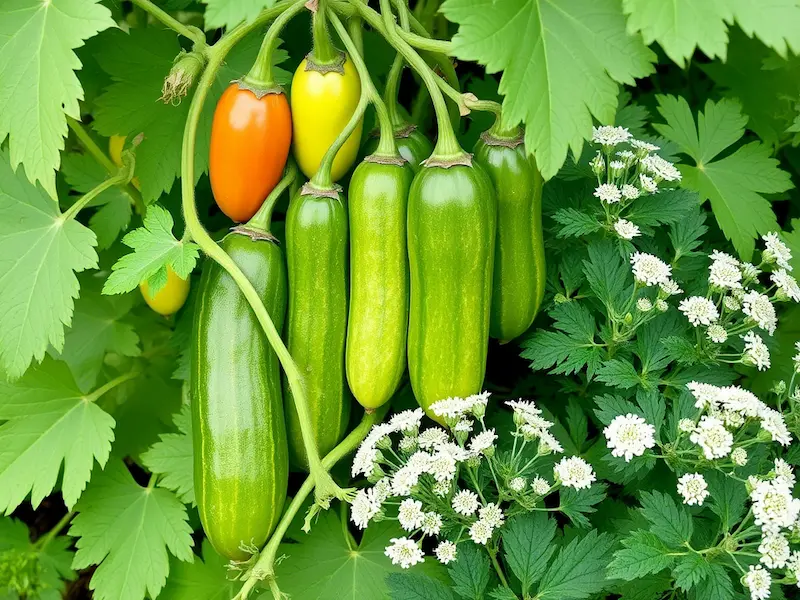
Basil
Basil is well-known for repelling mosquitoes and flies. It is a great partner for Yarrow. The two plants create a fragrant, pest-free garden environment while supporting the growth of neighboring vegetables like tomatoes and peppers.
Basil and yarrow also complement each other aesthetically, adding greenery and flowers to herb gardens.
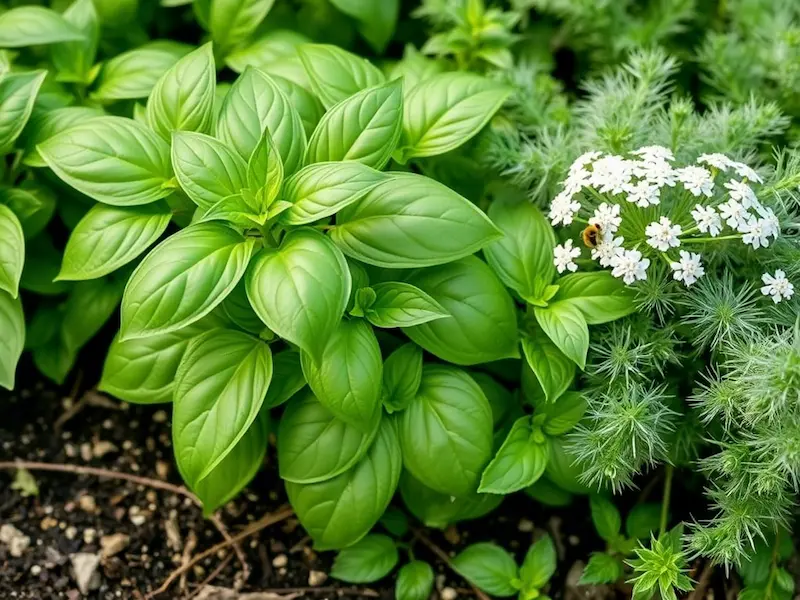
Lavender
Both yarrow and lavender are drought-tolerant, sun-loving perennials that thrive in similar conditions. Their combination results in a low-maintenance garden filled with beautiful purple and white flowers attracting bees and butterflies.
Lavender’s calming scent enhances the garden’s aroma, making it a relaxing space while keeping unwanted pests like moths away.
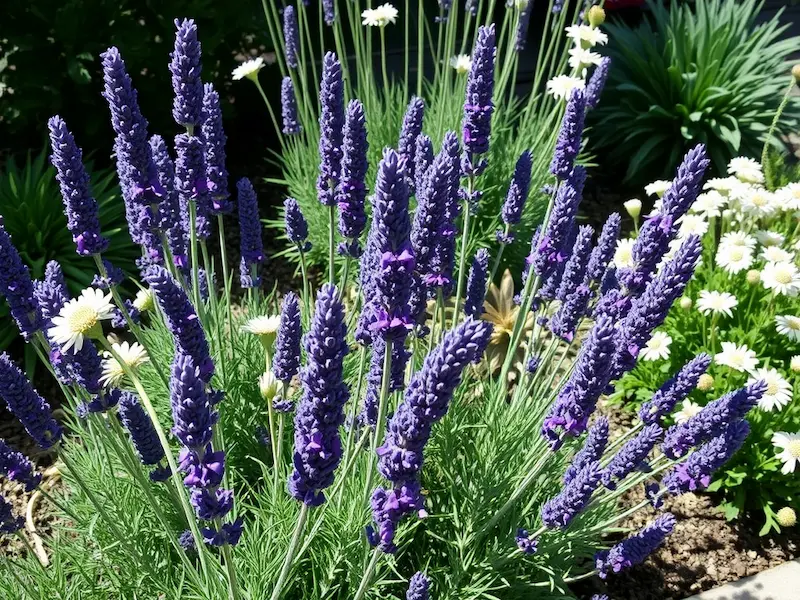
Rosemary
Rosemary prefers dry, sandy, well-drained soil, like yarrow. When planted together, they form a hardy, low-water garden bed that requires little maintenance.
Yarrow also attracts pollinators that can benefit rosemary’s small flowers, helping to boost growth and overall garden health.
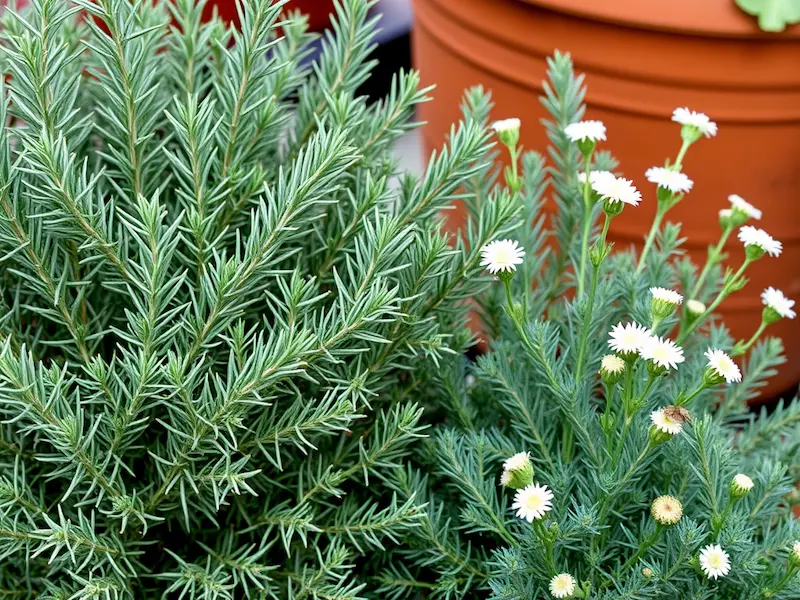
Echinacea (Coneflower)
Echinacea and yarrow are wildflowers that attract bees, butterflies, and hummingbirds. Their bright colors and similar growth habits make them perfect companions in a pollinator-friendly garden.
Since both plants are drought-resistant perennials, they can grow side by side without needing much water or maintenance.
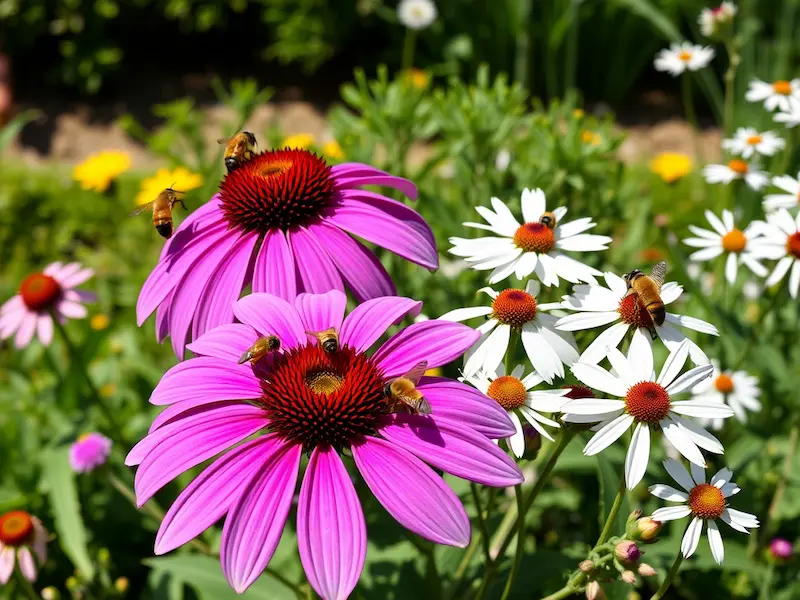
Black-Eyed Susan
Like yarrow, black-eyed susans thrive in full sun; their yellow and orange flowers contrast beautifully with yarrow’s white or pink blooms, creating a colorful, eye-catching garden bed.
Both plants attract butterflies and bees, helping to increase pollination and overall plant health in the garden.
Marigolds
Marigolds are famous for repelling pests like aphids, nematodes, and whiteflies. It is a great companion for yarrow.
When planted together, marigolds and yarrows create a natural pest barrier around vegetable gardens, reducing the need for chemical pesticides. Their vibrant yellow and orange flowers add beauty to any garden space.
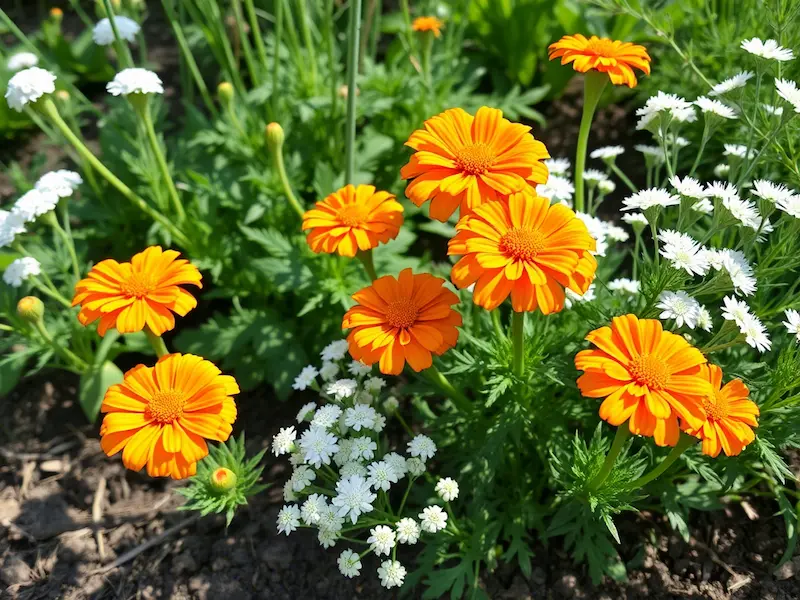
Strawberries
Strawberries require well-drained soil to prevent root rot. Yarrow naturally loosens compacted soil. It helps improve drainage, allowing strawberry plants to grow healthier and produce juicier, sweeter fruit.
Yarrow attracts bees, which play a key role in strawberry pollination, leading to larger and more abundant harvests.
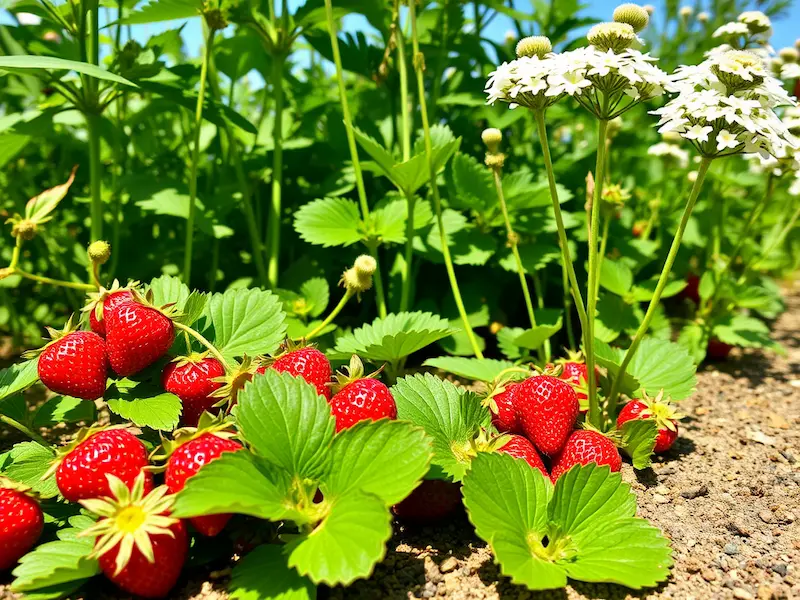
Blueberries
Blueberry plants need pollinators like bees and butterflies for fruit development. Yarrow is a pollinator magnet. Planting it near blueberry bushes can significantly improve their pollination success rate.
Yarrow can pull nutrients from deep in the soil. It benefits blueberries, ensuring they receive a steady supply of essential minerals.
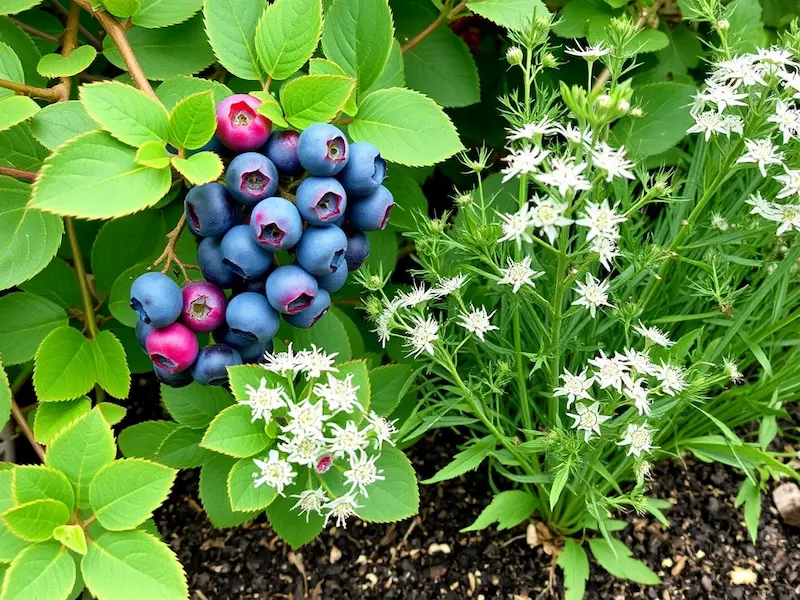
Final Thoughts
Yarrow is a versatile and beneficial companion plant for various vegetables, herbs, flowers, and fruit plants. Yarrow is an excellent choice to improve pollination, repel pests, enhance soil health, or create a colorful, low-maintenance garden.
What not to Plant with Yarrow
While yarrow (Achillea millefolium) is a beneficial companion plant, it does not pair well with all garden plants. Some plants may compete for resources, have different water needs, or grow aggressively, making them unsuitable companions for yarrows.
Here are five plants you should avoid growing with yarrow and why they aren’t a good match.
Mint
Mint is a fast-growing, invasive herb that spreads through underground runners. Planting near the yarrow can quickly overtake garden space, stealing nutrients and water from the yarrow and nearby plants.
- Why Avoid It?
- Mint’s aggressive growth can crowd out Yarrow.
- Competes for nutrients and soil space.
- Prefers moist soil, while yarrow thrives in dry conditions.
Alternative: Instead of planting mint near yarrow, grow it in containers or separate garden beds to prevent its spread.
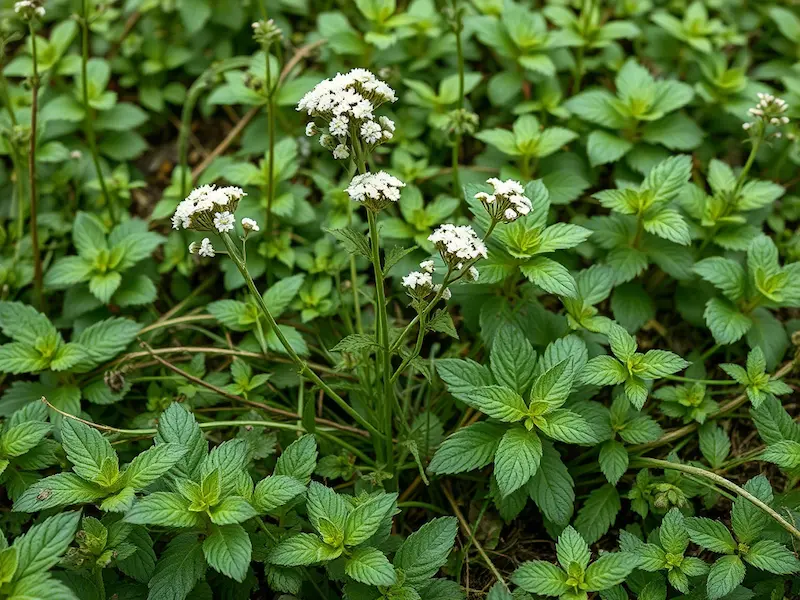
Lettuce
Lettuce is a shallow-rooted vegetable that requires constant moisture to prevent wilting and bitterness. On the other hand, Yarrow is a drought-tolerant plant that thrives in well-drained, dry soil. These different water needs make them incompatible garden companions.
- Why Avoid It?
- Lettuce needs frequent watering, which can cause root rot in yarrow.
- Yarrow prefers dry, well-drained soil, while lettuce wilts without moisture.
- Watering lettuce frequently may lead to overwatering yarrow, weakening its growth.
Alternative: Grow lettuce in a separate, moisture-rich garden bed away from drought-loving plants like yarrow.
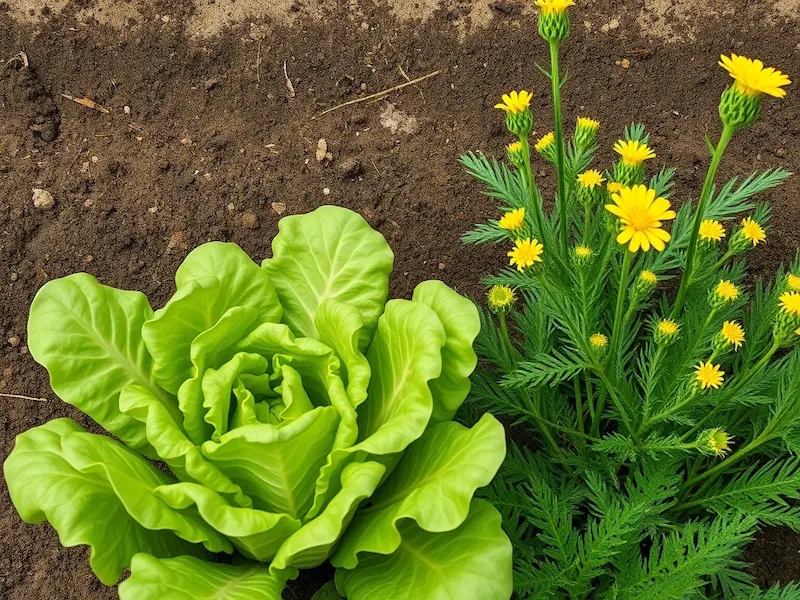
Spinach
Like lettuce, spinach is a water-loving, cool-season vegetable that struggles in dry, hot conditions. Yarrow’s preference for full sun and low water makes it a poor companion for spinach.
- Why Avoid It?
- Spinach needs consistent moisture, while yarrow thrives in dry soil.
- Prefers cooler temperatures, while yarrow does best in warm, sunny areas.
- Frequent watering of spinach can negatively affect yarrow’s growth.
Alternative: Grow spinach in a partially shaded area with consistent watering to keep it healthy.
Cilantro
Cilantro is an herb that requires moist, rich soil to grow well. It doesn’t tolerate dry conditions, making it an unsuitable match for yarrow, which thrives in poor, dry, well-drained soil.
- Why Avoid It?
- Cilantro needs frequent watering, which can cause overwatering issues for yarrow.
- Grows best in nutrient-rich soil, while yarrow can handle poor soil conditions.
- Has short growth cycles, meaning it bolts quickly in hot, dry conditions near the yarrow.
Alternative: Plant cilantro near parsley, basil, or chives, which have similar growing needs.
Hostas
Hostas are shade-loving perennials that need moist, nutrient-rich soil to thrive. Yarrow, however, requires full sun and well-drained, dry soil, making these two plants incompatible.
- Why Avoid It?
- Hostas prefer shade, while yarrow needs full sun.
- Yarrow’s drought tolerance makes it unsuitable for moist soil conditions needed by hostas.
- Hostas require rich, fertile soil, while yarrow grows well in nutrient-poor soil.
Alternative: Grow hostas in shaded garden beds with other moisture-loving plants like ferns and astilbes.
Final Thoughts
Yarrow is a fantastic companion plant but doesn’t get along with all garden plants. Plants that require moist, rich soil or grow aggressively should not be planted near the yarrow, as they can hinder its growth or suffer due to mismatched growing conditions.
Tips for Growing Yarrow with Companion Plants
Yarrow (Achillea millefolium) is a low-maintenance, hardy plant that thrives in varied garden conditions. However, to get the best results when growing yarrow alongside companion plants, you must consider location, spacing, and care techniques.
Follow these essential tips to ensure your yarrow and its companions grow together successfully.
Choose the Right Location
Yarrow is a sun-loving perennial that thrives in dry, well-drained soil. Choosing the right location is crucial for healthy growth and ensuring your companion plants benefit from yarrow’s presence.
✅ Best Growing Conditions for Yarrow:
- Sunlight: Needs at least 6-8 hours of direct sunlight daily.
- Soil Type: Prefers well-drained, sandy, or rocky soil.
- Watering Needs: Low water requirements—thrives in drought conditions.
Avoid planting yarrow in:
- Shady areas – It will become leggy and weak.
- Heavy clay soil – Poor drainage can cause root rot.
- Overly moist locations – Yarrow does best in dry soil with occasional watering.
Tip: If soil retains too much moisture, consider planting yarrow in a raised bed or sandy soil mix for better drainage.
Space Properly
Proper spacing is essential when growing yarrow with companion plants. Overcrowding can lead to poor air circulation, increased humidity, and disease development.
✅ Ideal Spacing for Yarrow:
- 12-24 inches apart to allow room for growth.
- Tall plants like tomatoes and echinacea should be placed at the back of a garden bed to prevent overshadowing smaller plants.
- Shorter plants like lettuce and strawberries should be placed in front or around the yarrow for a balanced layout.
Why is spacing important?
- Prevents mildew and fungal diseases caused by trapped moisture.
- Reduces competition for nutrients and sunlight.
- Helps beneficial insects move freely between plants for pollination and pest control.
Tip: If you’re planting yarrow in a pollinator garden, mix it with other flowering plants in a staggered pattern to create a more natural, wildflower-style arrangement.
Regular Pruning
Yarrow is a long-blooming perennial, but regular pruning is key to maintaining a healthy, attractive plant. Removing spent flowers helps prolong blooming, control spread, and prevent self-seeding.
✅ How to Prune Yarrow for Better Growth:
- Deadhead faded flowers – This encourages new blooms and extends the flowering period.
- Cut back in late summer – After the first bloom cycle, trim stems by one-third to promote a second flush of flowers.
- Trim in early spring – Remove dead or weak stems to allow fresh growth.
What happens if you don’t prune yarrow?
- Becomes leggy and unkempt.
- May self-seed aggressively, spreading uncontrollably.
- Older flowers will block new buds from developing.
Final Thoughts
Growing yarrow with companion plants can improve your garden’s health, biodiversity, and visual appeal. You can ensure yarrow and its companions thrive together by selecting the right location, correctly spacing plants, and keeping up with pruning.
FAQs About Companion Planting Yarrow
Yes! Yarrow is an excellent companion plant for vegetable gardens because it attracts beneficial insects that help control pests and improve pollination.
How Does Yarrow Benefit Vegetables?
- Attracts Pollinators – Bees and butterflies love yarrow, which helps increase fruit and vegetable production.
- Lures Predatory Insects – Ladybugs, lacewings, and hoverflies feed on aphids, caterpillars, and other harmful pests.
- Enhances Soil Quality – Yarrow’s deep roots break up compacted soil and improve nutrient circulation.
- Repels Harmful Pests – Its scent deters mosquitoes, aphids, and cabbage worms, reducing the need for chemical pesticides.
Yes, a yarrow can spread quickly, but you can control its growth correctly.
Why Does Yarrow Spread?
- Yarrow grows through underground rhizomes, meaning it spreads naturally over time.
- It self-seeds easily, significantly, if the flowers are not trimmed after blooming.
How to Control Yarrow’s Growth:
- Prune Regularly – Cut back spent flowers before they drop seeds.
- Divide Clumps – Every 2-3 years, dig up and divide large yarrow plants to keep them manageable.
- Use Barriers – If you want to contain a yarrow, plant it in raised beds or garden borders.
Conclusion:
“Yarrow (Achillea millefolium) is more than just a beautiful, drought-tolerant plant. It is a powerhouse companion for any garden. Whether you are growing vegetables like collard greens, aromatic herbs, or vibrant flowers, yarrow boosts soil health, attracts pollinators, and repels pests naturally. Its ability to deter cabbage worms makes it an especially valuable ally for brassicas like collards, while its deep roots mine nutrients to share with neighboring plants. (Want to maximize Collards’ growth? Explore our guide to Collards Companion Plants for more tips on perfect pairings!)
Why should you plant yarrow?
- 🐝 Attracts bees, butterflies, and pest-eating insects.
- 🌱 Improves soil structure and adds organic matter.
- 🛡️ Repels aphids, mosquitoes, and cabbage moths.
- 💧 Thrives in poor soil with minimal watering.
To avoid overcrowding, pair yarrow with plants that share its love for well-drained soil, like tomatoes or lavender, and avoid water-sensitive crops like lettuce. With smart spacing and occasional pruning, yarrow becomes a low-maintenance secret weapon for gardens of all sizes. Whether you’re a new gardener or a seasoned pro, yarrow’s versatility and resilience make it a must-have for thriving, eco-friendly gardens.

- Be Respectful
- Stay Relevant
- Stay Positive
- True Feedback
- Encourage Discussion
- Avoid Spamming
- No Fake News
- Don't Copy-Paste
- No Personal Attacks



- Be Respectful
- Stay Relevant
- Stay Positive
- True Feedback
- Encourage Discussion
- Avoid Spamming
- No Fake News
- Don't Copy-Paste
- No Personal Attacks

